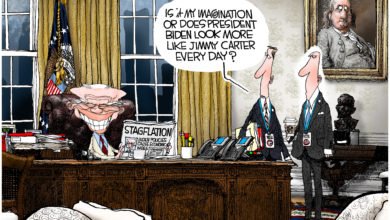No Joe, Bidenomics Is Not Working
This past week as he marked the one-year anniversary of the Inflation Reduction Act, President Biden said that his economic policies known as “Bidenomics” are working. Assuming the goals of economic policy are price stability, full employment and economic growth, his policies fail. In other words, Bidenomics is not working.
The White House says the policies are “rooted in the recognition that the best way to grow the economy is from the middle out and the bottom up.” This seems to be geared to refute Reaganomics, which was mostly based on creating new capital for expansion to grow the economy from the top down while easing the tax burden on all Americans.
Reagan cut taxes for all Americans including those higher-income earners who create new capital. He also reduced unnecessary regulations. That tended to encourage growth and increase total supply in the economy. The middle-class tax cuts increased consumption, meaning total demand increased.
With this balance between more supply and more demand, the economy grew, unemployment fell and prices stabilized, so all of the economic goals were reached. In fact, after the Reagan tax cuts, the economy went on a 25-year growth spurt, except for two small hiccups in 1991 and 2001.
Inflation remained very low until 2021.
Biden’s policies spent trillions of dollars that the government did not have. When Biden’s first term is up, he will have created more deficit spending (nearly $8 trillion) than any president ever before him. That will bring the total public debt to more than $34 trillion.
Biden claims to be making investments in the future. He says this is like the huge investment the U.S. made in the 1950s to expand the highway infrastructure. He says his investments in infrastructure, electric vehicles, solar energy and semiconductors will provide better returns than the highway spending in the 1950s.
In the 1950s, the federal government made these investments while balancing the budget. Biden’s investments are all made by borrowing money. That leads to excess demand and is extremely inflationary.
Biden’s $3 trillion deficit spending in 2021 contributed greatly to the inflation problem that continues today. He claims his policies have reduced inflation from 9% in mid-2022 to just over 3% today. But it was mostly his policies that raised inflation in the first place.
The reality is that the Federal Reserve’s tight money policy. started in June 2022. is what brought the inflation rate down. In 2021, Biden convinced the Fed to keep interest rates near zero and vastly increase the money supply to finance his deficit spending. That shockingly irresponsible monetary policy also contributed to the inflation problem.
Biden’s policies also include huge investments in clean energy while reducing domestic production of fossil fuels. That led to higher energy prices, which also contributed to inflation. While producing clean energy makes sense, if the marketplace supports it, restricting the supply of fossil fuels while the market demand is high, is purely inflationary.
Biden claims his policies have reduced inflation. In fact, his policies increased inflation. Even though the inflation rate has fallen, it is still more than twice as high as when he entered office in January 2021.
Bringing the inflation rate down is good, but even with a lower rate of inflation, prices are more than 16% higher than they were when he entered office — and inflation is about to increase.
Much of the reduction in the inflation rate came, not only from the Fed’s policy, but also from falling energy prices. Energy prices have risen significantly in the past month and are headed higher. Have you purchased gasoline lately?
By year end, the inflation rate for 2023 will probably be in the 4% to 5% range. Also, the Fed will have raised interest rates two more times. That means the Federal Funds rate will be over 6%. Mortgage rates will approach 8%.
Bidenomics has produced record government spending, record budget deficits, a record high public debt, more growth-slowing regulations, market distortions that reduce efficiency and higher taxes. As we move toward year-end and into 2024, the economic problems will worsen.
Eventually, consumers will resist the higher prices so total demand will fall. That will lead to a recession, possibly before the end of the year, paired with higher unemployment.
In the longer term, the current inflation will lead to a wage-price spiral. Labor seeks huge wage increases, which increase labor costs for businesses. To maintain profitability, business will have to raise prices, leading to yet more inflation. Then labor will seek higher wage increases. UPS, those in the entertainment industry and the auto workers, for example, seek much higher wages.
In a word, Bidenomics has been a disaster.
Agree/Disagree with the author(s)? Let them know in the comments below and be heard by 10’s of thousands of CDN readers each day!





A good summary of what we all kind of know has happened. Great to have factual documentation. Crazy to think he did all that harm from a bicycle seat and a beach chair, who is pulling the strings? Is it Soros?? or Obama?? Dump the Dumbos.